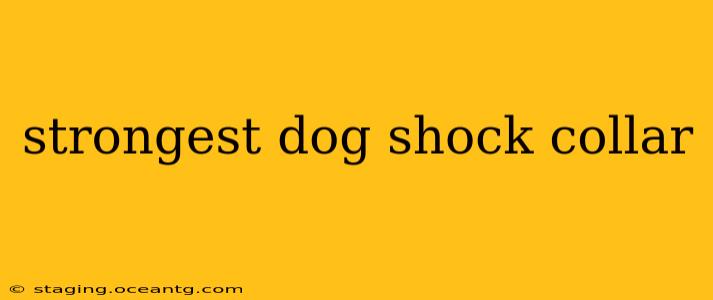Choosing the right shock collar for your dog can be daunting. With so many options on the market, it's crucial to understand what makes a collar "strong" and which features are essential for safety and effectiveness. This guide will delve into the factors determining a collar's strength, address common concerns, and help you choose the best option for your canine companion. It's crucial to remember that using any shock collar requires responsible and humane training techniques. Improper use can be harmful to your dog.
What Makes a Dog Shock Collar "Strong"?
The "strength" of a dog shock collar isn't solely about the intensity of the shock. Instead, it's a combination of several factors:
- Range: A strong collar boasts a significant range, allowing you to control your dog from a considerable distance. This is particularly important for training in larger areas or recall exercises.
- Signal Strength: This refers to the reliability and clarity of the signal transmitted from the remote to the collar. A strong signal ensures consistent stimulation, regardless of environmental interference.
- Battery Life: A long-lasting battery is essential for prolonged training sessions. A weak battery can lead to inconsistent performance and frustration.
- Shock Levels/Intensity: While high intensity might seem desirable, it's crucial to select a collar with adjustable levels to match your dog's sensitivity and the specific training scenario. Always start with the lowest level and gradually increase only if necessary.
- Durability: A robust collar built from high-quality materials can withstand the rigors of outdoor training and your dog's activity levels. Look for water-resistant or waterproof designs for added durability.
- Receiver Strength: The receiver on the collar itself needs to be strong and reliable to accurately receive and interpret the signals from the remote.
How to Choose the Right Shock Collar Strength
Choosing the appropriate strength depends heavily on your dog's size, temperament, and the training goals. Never choose a collar based solely on its maximum shock level.
- Small Dogs: Small breeds require collars with lower stimulation levels and shorter ranges. Overly strong stimulation can be harmful to smaller dogs.
- Large Dogs: Larger, more powerful breeds might benefit from collars with a longer range and potentially higher stimulation levels, but still within safe and humane parameters.
- Stubborn Dogs: For dogs that are less responsive to training, a collar with adjustable intensity levels can be useful, allowing you to gradually increase the stimulation as needed. However, this should always be coupled with positive reinforcement methods.
- Training Goals: The type of training will influence the needed range and features. For recall training in a large field, a longer range is crucial. For obedience training in a smaller area, a shorter range might suffice.
What are the Best Features of a Strong Shock Collar?
Beyond the basic strength elements, several features contribute to a high-quality and effective collar:
- Multiple Stimulation Modes: Some collars offer different stimulation modes beyond just shock, such as vibration or tone, providing a wider range of training options.
- Waterproof/Water-Resistant Design: Essential for dogs that enjoy swimming or outdoor activities in wet conditions.
- Rechargeable Battery: Rechargeable batteries are more environmentally friendly and cost-effective in the long run.
- Comfortable Fit: The collar should fit comfortably without being too tight or loose.
- Durable Materials: High-quality materials ensure the collar lasts and can withstand your dog's activities.
Is a Strong Shock Collar Right for My Dog?
Shock collars can be effective training tools when used responsibly and ethically. However, they are not suitable for every dog or every situation. Consider alternatives like positive reinforcement training methods before resorting to a shock collar. Consult with a certified professional dog trainer to determine if a shock collar is appropriate for your dog and your training goals. They can help you establish a safe and effective training plan.
Are Strong Shock Collars Cruel?
The ethical use of shock collars is a subject of debate. While some argue they are inhumane, others find them effective when used correctly and responsibly. The key is humane usage, which involves starting with the lowest stimulation level, focusing on positive reinforcement alongside the collar, and seeking professional guidance. Misuse can be cruel and damaging to your dog's emotional well-being.
How to Use a Strong Shock Collar Responsibly?
Responsible shock collar use involves:
- Professional Guidance: Consult a certified dog trainer for personalized advice and training strategies.
- Start Low and Gradually Increase: Begin with the lowest stimulation level and only increase if necessary.
- Combine with Positive Reinforcement: Pair the stimulation with positive reinforcement techniques like treats and praise.
- Monitor Your Dog: Closely observe your dog's reaction to the stimulation and adjust accordingly.
- Never Use as Punishment: The shock should be used as a signal, not as a punishment.
- Regularly Check the Collar: Ensure the collar fits correctly and is in good condition.
Choosing the "strongest" dog shock collar is not about selecting the collar with the highest shock intensity. It's about finding a collar with a robust signal, long range, durable build, adjustable intensity levels, and utilizing it responsibly and ethically. Always prioritize your dog's safety and well-being. Remember that responsible training methods, combined with humane tools when necessary, lead to the best outcomes.
